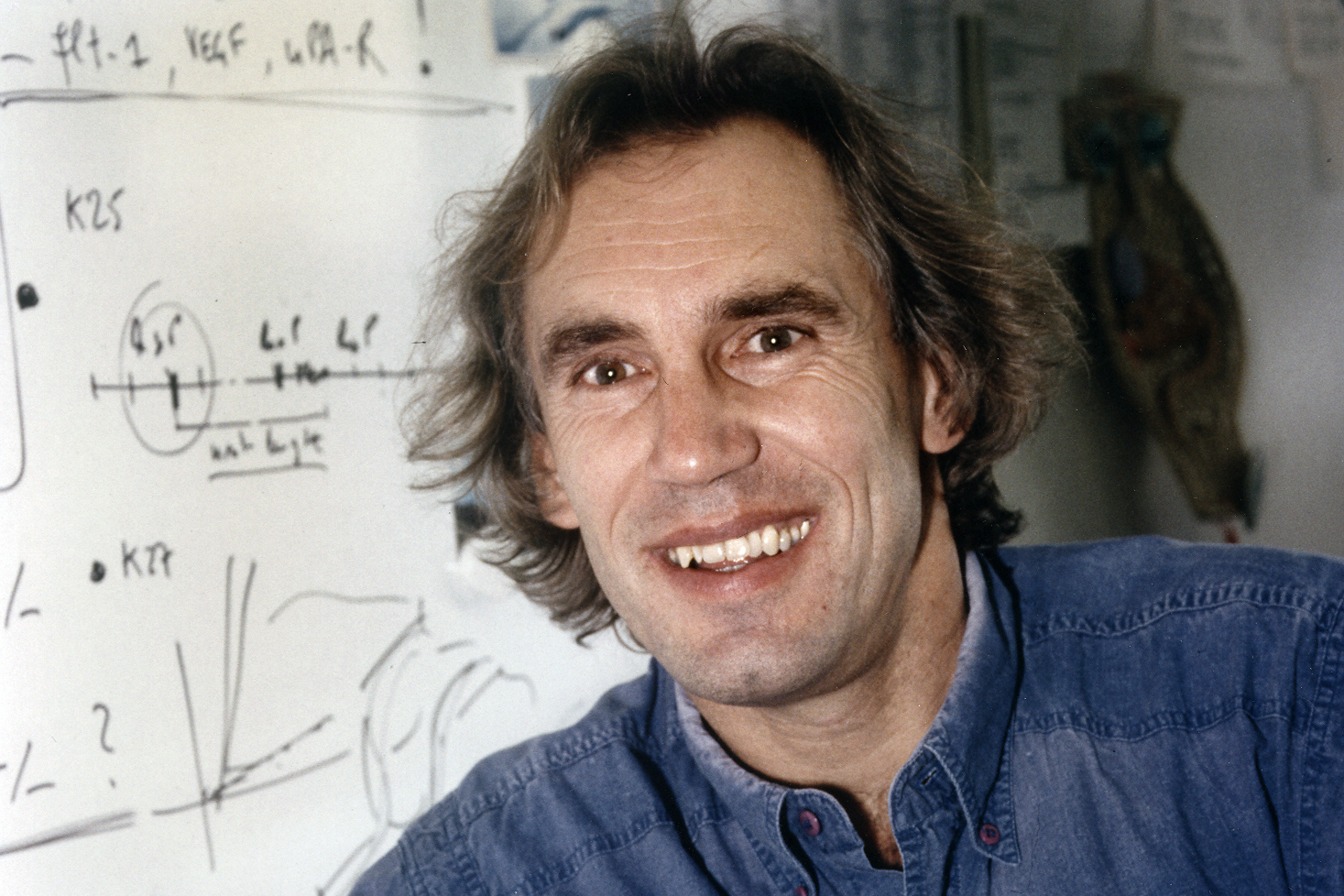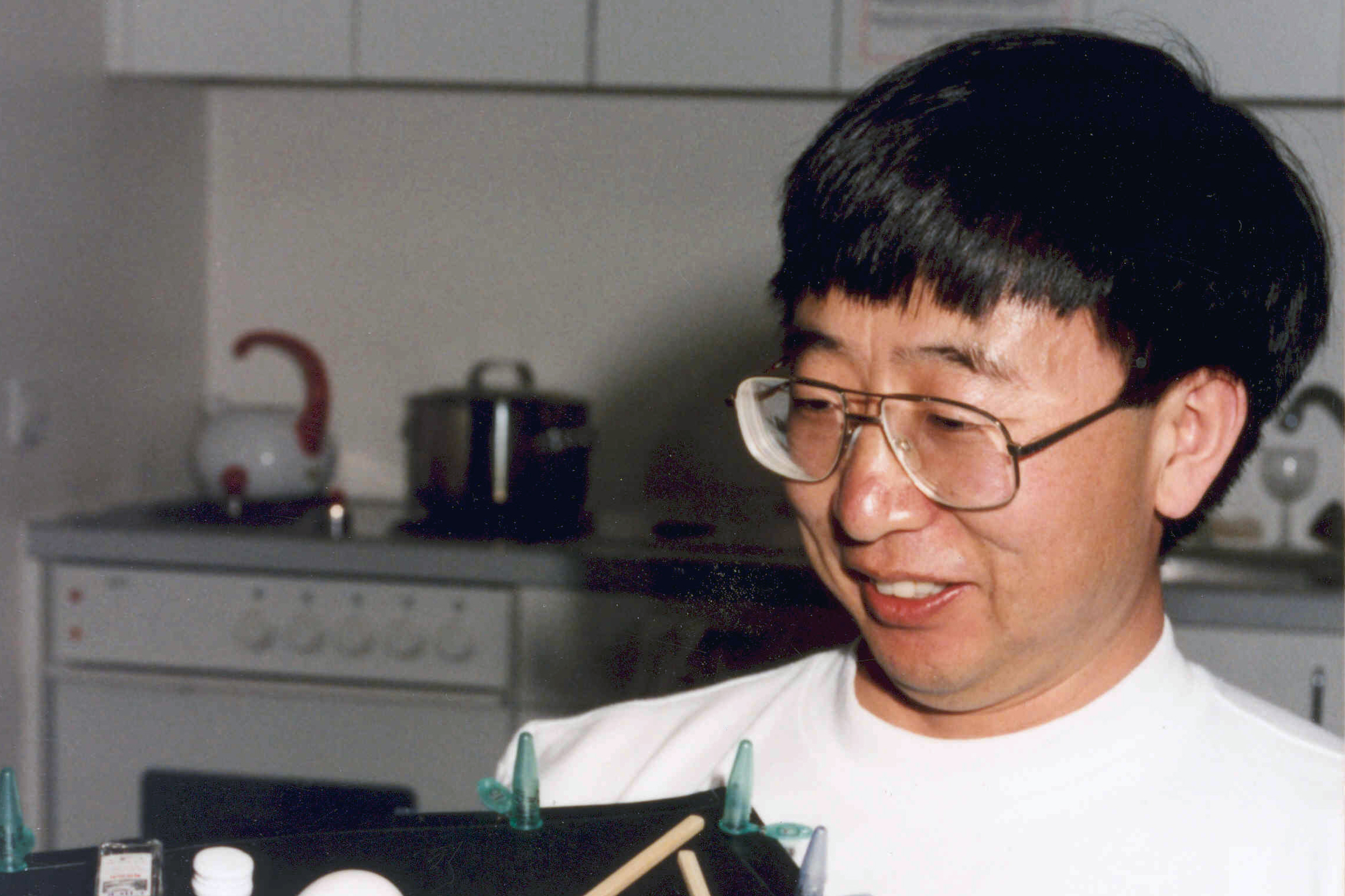AP-1 – a key transcription factor complex in cell differentiation, inflammation and cancer
Transcription factor complexes control cell proliferation, differentiation and transformation. For example, “activator protein 1” (AP-1) is an evolutionarily conserved transcription factor complex that regulates cell physiology in response to environmental changes. During his 20 years at the IMP, Erwin Wagner focused much of his research on AP-1, using pioneering mouse models to study diseases such as psoriasis and cancer.

During his postdoc (1979-1983) with Beatrice Mintz at the Fox Chase Cancer Center in Philadelphia, Erwin Wagner was instrumental in creating some of the first transgenic mice. Upon becoming a group leader at EMBL Heidelberg in 1983, Erwin focused his work on oncogenes and began to study the role of the c-fos oncogene in cell differentiation. He knew Max Birnstiel from conferences, and it was at one such conference, at Cold Spring Harbor around 1986, that Max floated the idea of Erwin joining the new IMP institute. “Don’t you think it would be time for you to go back to Austria?”, he joked. Erwin worked in the same cell differentiation program at EMBL as Hartmut Beug, who had also been approached by Max regarding the IMP. “The two of us basically moved to the IMP together”, says Erwin. With them, they brought unparalleled expertise in the latest mouse technologies and oncogene research.
Erwin continued working on the AP-1 transcription factor complex, which is a heterodimer of Fos and Jun subunits. While at EMBL, his group showed that overexpression of c-Fos affected the development of bone, cartilage, and blood cells in transgenic mice. These findings suggested that c-Fos has tissue-specific functions, but the physiological relevance of these findings was unclear without loss-of-function studies.

The technology for generating knockout mice was just emerging. Zhao-Qi Wang, who joined the lab as a postdoc a few months before the move to the IMP in October 1988, was interested in these new techniques and set about using the latest know-how to try and generate c-Fos knockout mice. “I was assigned the job of optimising the culture conditions for embryonic stem cells to ensure germline transmission, which was a major hurdle”, says Zhao-Qi, who is now a professor at the University of Jena and leads a research group at the Leibniz Institute on Aging. It was a huge effort and it took almost two years to test all the parameters. But Zhao-Qi succeeded and discovered that mice lacking c-Fos were smaller, had altered haematopoiesis, and developed osteopetrosis (whereby bones are denser than normal) (Wang et al, Nature 1992). These findings were consistent with the overexpression studies, and demonstrated that c-Fos has specific functions in bone, cartilage and blood cell development.
The c-Fos knockout was one of the first knockout mice. Mario Capecchi, Martin Evans, and Oliver Smithies had created the very first knockout mice in 1989 and went on to receive the 2007 Nobel Prize in Physiology or Medicine for their work. Continuing to investigate the c-Fos mutant mice, Erwin’s group showed that c-Fos is a key regulator of osteoclast-macrophage lineage determination (Grigoriadis et al, Science 1994). Therefore, a lack of differentiated osteoclasts in mice without c-Fos leads to insufficient bone resorption and hence denser bones.
Having established the know-how to create mouse knockouts, Erwin’s group went on to knock out other components of the AP-1 complex. For example, knocking out the Jun family member c-Jun was lethal to mouse embryos, with further analysis showing that c-Jun is essential for liver development (Hilberg et al, Nature 1993). The researchers also generated conditional knockout mice to unambiguously study the tissue-specific functions of AP-1 members. Staying with c-Jun as an example, hepatocyte-specific deletion of c-Jun in a mouse model of liver cancer showed that c-Jun promotes liver cancer by antagonising p53 activity and thereby preventing apoptosis (Eferl et al, Cell 2003). Interestingly, epidermal deletion of JunB and c-Jun in adult mice led to a phenotype resembling psoriasis, an inflammatory disease of skin and joints (Zenz et al, Nature 2005). This work provided a valuable mouse model for psoriasis-like skin disease and arthritis. “I think a good mouse model that can be validated by ‘omics’ approaches or epigenetic profiling, et cetera, is still the gold standard if you want to understand mechanisms of disease”, Erwin says. Indeed, the model for psoriasis has been used to test all the therapies currently on the market.
Erwin’s group also shared their expertise in creating mouse knockouts with other groups at the IMP, leading to several fruitful collaborations; for example, with Denise Barlow’s group to knock out Igf2 (Wang et al, Nature 1994) and with Meinrad Busslinger’s group to knock out Pax5 (Urbánek et al, Cell 1994). In essence, they helped to establish the IMP as a key institute for mouse genetics.
Erwin served as Scientific Deputy Director from 1997 until he left the IMP in 2008 to become Deputy Director and Head of the Cancer Cell Biology Program at the Spanish National Cancer Research Center (CNIO) in Madrid. He returned to Austria in 2019 to join the Medical University of Vienna, supported by a recently awarded ERC-Advanced Grant. His work has been recognised by numerous prizes, including the first Wittgenstein Prize in 1996 and the EMBO medal for the development of gene transfer techniques in mice. Given the number of different Fos and Jun subunits, the plethora of AP-1 interacting proteins, and the crosstalk with other transcription factors, research on AP-1 is far from complete, and Erwin’s work continues to provide new insights with therapeutic relevance.
First published in 2020.
References
Bone and hematopoietic defects in mice lacking c-fos.
Wang ZQ, Ovitt C, Grigoriadis AE, Möhle-Steinlein U, Rüther U, Wagner EF; Nature 1992
C-jun is essential for normal mouse development and hepatogenesis.
Hilberg F, Aguzzi A, Howells N, Wagner EF; Nature 1993
C-fos - a key regulator of osteoclast-macrophage lineage determination and bone remodelling.
Grigoriadis AE, Wang ZQ, Cecchini MG, Hofstetter W, Felix R, Fleisch HA, Wagner EF; Science 1994
Regulation of embryonic growth and lysosomal targeting by the imprinted Igf2/Mpr gene.
Wang ZQ, Fung MR, Barlow DP, Wagner EF; Nature 1994
Complete block of early B cell differentiation and altered patterning of the posterior midbrain in mice lacking Pax5/BSAP.
Urbánek P1, Wang ZQ, Fetka I, Wagner EF, Busslinger M; Cell 1994
Liver tumor development: c-Jun antagonizes the proapoptotic activity of p53.
Eferl R, Ricci R, Kenner L, Zenz R, David JP, Rath M, Wagner EF; Cell 2003
Psoriasis-like skin disease and arthritis caused by inducible epidermal deletion of Jun proteins.
Zenz R, Eferl R, Kenner L, Florin L, Hummerich L, Mehic D, Scheuch H, Angel P, Tschachler E, Wagner EF; Nature 2005